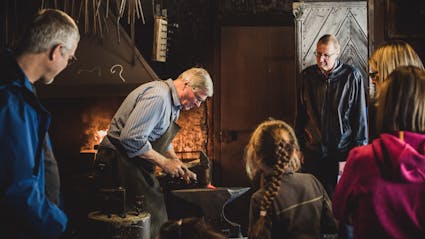Forging
The regular ring of a hammer can be heard from a distance as one approaches the Smithy from Bümpliz BE (1052). The blacksmith is at work in the imposing half-timbered house with its great doors. Courses run by the Ballenberg Course Centre are often held in the old village smithy. He is working on a red-hot rounded nail rod on the anvil, shaping the point of the nail with confident blows of the hammer: he hammers and turns, then hammers and turns again. He then cuts the nail off to the required length. Finally, he inserts it into a perforated plate and forges the head.

From the all-rounder to the specialist
Nails played a central role in the history of rural Switzerland. The demand for nails increased with the increase in building activity. Nail forges were specialized in the production of very varied types of nails: horseshoe nails, plank nails, shingle nails, lock nails, masonry nails, shoe nails and so on. The profession has changed over the decades. Whereas the village blacksmiths were once all-rounders, with time they specialized and became, for example, farriers or cutlers. Many an all-round blacksmith had to look for a new occupation, such as a metalworker, bathroom plumber, or, with the arrival of agricultural machinery, mechanic. However, there still exist apprenticeships today for learning the trade of a general blacksmith or farrier. These days the Ballenberg-blacksmith not only forges nails in the smithy, but also repairs tools and carries out general repairs for the museum.
Ballenberg
Swiss Open-Air Museum
Museumsstrasse 100
CH-3858 Hofstetten bei Brienz
Company holidays
24 December 2025 to 11 January 2026
Opening hours Administration
3 November 2025 to 8 April 2026
From Monday to Friday
8.30 am to 11.30 am
1.30 pm to 4.30 pm
Opening hours
9 April to 1 November 2026
10 am to 5 pm daily